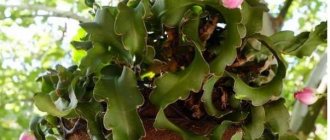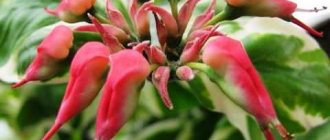Author: Elena N. https://floristics.info/ru/index.php?option=com_contact&view=contact&id=19 Category: Houseplants Published: February 27, 2019Last edits: January 11, 2021
- Growing from seeds
- Epiphyllum oxypetalum
Epiphyllum (lat. Epiphyllum) belongs to the genus of epiphytic plants of the Cactus family, numbering about 20 species. The name of the plant indicates the presence of leaves: επι in Greek means “on”, “on top”, and φυλλον - leaf. Sometimes epiphyllum is called phyllocactus or phyllocereus. Mexico, as well as the tropics and subtropics of America, are considered the birthplace of the flower. The epiphyllum plant was first described in 1812 by Adrian Haworth. Epiphyllum cactus is a popular houseplant.
What are epiphytic cacti and what are their features?
These varieties of succulents are members of the cactus family (Cactaceae), native to the tropical forests of South and Central America, at altitudes ranging from 900 to 1500 m. These rainforest cacti get their name epiphytic because they grow on other plants (usually trees or shrubs). , although they are not parasites. Unlike most cacti, which live in arid desert conditions, epiphytic cacti growing in tropical forests can receive up to 400 cm of rainfall annually.
Most cacti in this group grow among fallen leaves high on tree branches in the rainforest. They get water from the air and nutrients from rotted leaves and forest organic matter. With their roots, they are fixed in the forks of tree branches, where organic remains decompose. This light, loose medium allows water and oxygen to reach plant roots, which absorb water and dissolved nutrients. Some varieties of epiphytes grow on rocks and have hard roots in the ground (lithophytes).
Epiphytic cacti are a wonderful collection of leaf succulents with some of the most unexpected and exceptional features anyone who purchases this plant species will encounter.
Reproduction methods
Epiphyllum is propagated in three main ways:
- sowing seeds;
- dividing the bush;
- cuttings
Seeds are sown in damp sand or a special soil mixture for succulents. They are buried 5 mm, the container is covered with glass and kept at a temperature of +20…+23°C. It is necessary to ventilate the plantings daily and spray them with a spray bottle. Within 2-3 weeks, the first faceted stems will appear on the soil surface. With the emergence of seedlings, the shelter is removed. Only when the plants reach a height of 3-5 cm are they carefully transplanted individually. Seedlings bloom from the fifth year of life.
Strongly overgrown epiphyllum bushes can be divided into several parts. The best time to divide is late summer, when flowering is complete. The plant is removed from the pot, freed from most of the earthen coma, the rhizome is inspected and dry or rotten areas are removed. Then the bushes are divided so that each division has its own roots. The cut areas are dipped in crushed charcoal. Immediately after treatment, new bushes are planted in pots.
The best time to root cuttings is the second half of spring. To do this, it is necessary to cut off the top of a shoot 10-12 cm long from an adult plant. The cut is made at an angle, then the cutting is air-dried for 1-2 days and planted in garden soil with the addition of perlite. There is no need to deepen the seedling too much; just press it into moist soil to a depth of 1 cm. It is recommended to sprinkle the surface of the ground with sand. The cuttings are covered with a cap for 1-1.5 weeks. To prevent them from falling over, it is recommended to create a support.
Disocactus
The genus Disocactus (obsolete Aporocactus) belongs to the plant tribe Hylocereeae and grows as forest leaf cacti - epiphytes (on trees) or lithophytes (on rock formations). Native to parts of Mexico, Central America and the Caribbean, this plant is a challenge for the experienced gardener.
Growing Disocactus species can be challenging, but once you learn how to care for your succulent when your plant reaches maturity, you'll enjoy the magic of these fragrant, night-time bloomers. Flowers are formed along the entire length of the stems or at the growing ends of the cacti (depending on the species).
Disocactus flagelliformis
Disocactus or Aporocactus whip-shaped has a rounded stem structure, with thick and hanging stems reaching a length of 1 m, and almost 2 cm in width.
These bright green stems are covered with clusters of indistinct tufts of needles, each composed of thin orange spines. The flowers are large and beautiful, appearing en masse along the stems in late spring - early summer.
Brief description of cultivation
- Bloom . As a rule, it is observed in April–June. In some cases, the cactus can bloom twice a year.
- Illumination . The light should be bright, but diffused. It is better to choose a window with east or west orientation.
- Temperature regime . During the growing season - from 20 to 25 degrees, and in November-February - from 10 to 15 degrees.
- Watering . During active growth, water systematically, immediately after the top layer of the soil mixture has dried. In winter, the flower does not need watering.
- Air humidity . The plant is undemanding to humidity levels. However, experts advise that on hot days, moisten it in the evening from a sprayer with non-cold water.
- Fertilizer . During the period of active growth, once every 15 days, fertilizer for cacti is used. During the formation of buds, they are fed with organic matter (mullein is combined with water in a ratio of 1:4). During the dormant period, the plant is not fed.
- Rest period . From the last days of October until March.
- Transplant . While the cactus is young, it is replanted once a year in the spring, at the very beginning of the growing season. Transplantation of adult bushes is carried out only when it is absolutely necessary, immediately after flowering.
- Reproduction . By cuttings and seed method.
- Trimming . It is carried out once every 2 or 3 years in the spring at the very beginning of active growth. At this time, all thin, round and faceted stems are cut out. They also remove all those branches that bloomed 2 or 3 years ago.
- Pests . Scale insects, mealybugs, aphids and spider mites.
- Diseases . Fusarium, anthracnose, black rot and rust.
Epiphytic cacti of the genus Epiphyllum (Epiphyllum)
There are 19 species in this genus, all of which exist as epiphytes with thick, wide and flattened stems, mostly with wavy, lobed edges. Epiphyllum cacti are characterized by large, impressive flowers. In the last few years, the plants have undergone extensive hybridization to produce a variety of flowers in varying shades.
Epiphyllum is an easy-to-grow and fast-growing genus of succulent that enjoys moist, humus-rich soil and partial shade.
Epiphyllum serrated
The beautiful flowers of Epiphyllum crenatum grow from late spring to early summer. The flower itself is cup-shaped with long, creamy-white inner tepals and pale yellow stamens.
In total, the flower can reach 29 cm in length and up to 20 cm in width, has a strong aroma and is nocturnal, opening at night to attract insects for pollination. The flowers will remain open for several days.
Cactus Epiphyllum acupetallus
Epiphyllum oxypetalum is widely known as the only Epiphyllum species to be widely used for cross-pollination with other genera, such as Disocactus, in an attempt to develop a range of colored hybrids.
Epiphyllum acupetallus
The flower color of Epiphyllum hybrid varieties varies from white to light yellow and orange, and sometimes dark amber hybrids can be found.
Diseases and pests
| Disease or pest | External signs | Method of treatment |
| Mealybugs |
|
|
| Shchitovka |
|
|
| Spider mite |
|
|
All fungal diseases are cured after treating the plant with fungicidal substances. The diseased epiphyllum is removed from other flowers until completely cured.
External signs of epiphyllum diseases
Spider mites are recognized by brown spots and small webs
Brown spots are actually scale parasites
Mealy beetle is a parasite that infects shoots
Epiphytes Hylocereus
The unusual leaf cacti of the genus Hylocereus are among the largest of the epiphytic cacti. These large, climbing semi-epiphytes native to Central and North America have fleshy, articulated stems with aerial roots. They use their roots to cling to trees and shrubs in dry and open forested areas.
Their triangular stems grow to an impressive 5m in length, allowing them to reach a total height of up to 10m. The fruits of the Hylocereus species are completely edible. They contain white pulp studded with hundreds of black seeds. They are also called “dragon fruit”. These exotic-looking fruits are now grown for juice, wine and liquor and eaten fresh in many countries around the world.
Hylocereus wavy or Hylocereus sinuous (Hylocereus undatus)
This ampelous cactus is the most cultivated of all species of the genus Hylocereus. Dark-colored spines grow only on the mature branches of this climbing cactus, and gorgeous flowers bloom at the ends of the branches.
In summer, the ripe buds bloom and a white, bell-shaped flower appears. These powerful and fragrant flowers reach 35 cm in length and up to 30 cm in diameter, opening at dusk for one night only.
Epiphytes of the genus Hatiora
The next genus of epiphytic cacti is Hatiora, native to the tropical forests of southeastern Brazil. In nature, they grow on trees and sometimes on rocks. All plants of this genus have succulent stems that grow straight or trailing, without thorns.
This genus is divided into two subgenera - Hatiora and Rhipsalidopsis, each of which has the following distinctive characteristics and plant forms:
- Plants of the subgenus Hatiora typically have a woody base, a cylindrical segmented stem structure, and an erect growth habit. The flowers of this subgenus are usually quite small and come in red, orange and pink colors.
- Plants of the subgenus Rhipsalidopsis have a more flattened structure in the form of segments of a more pendulous stem. The flowers are much larger in size and are red or pink in color. There is only one exception, Hatiora epiphylloides with small yellow flowers.
Hatiora gaertneri
The well known Hatiora gaertneri, also called "Easter cactus" in the west. One of the most famous epiphytic cacti, which even amateur gardeners know about. This plant belongs to the tribe Rhipsalideae.
It has flattened, segmented, pendulous stems with flowers appearing from March to April. These wonderful tube-shaped flowers grow at each end of the stem and vary in shades of red or pink and have lighter stamens. The flowering period can be extended if suitable conditions are created - more water and a cool evening temperature of about 7-8 degrees.
Hatiora herminiae
Another representative of epiphytes is Hatiora herminiae, a representative of the subgenus Hatiora. Erect, with a cylindrical segmented stem structure.
Its unique and mostly solitary flowers grow again at the top of the stem, a beautiful deep pink color, each growing to approximately 2.5cm in length. The fruits of Hatiora herminiae reach 8 mm in length and are olive green in color.
These types of tree cacti are relatively easy to grow, preferring environments with high humidity and cooler temperatures than most other tropical plants.
Caring for epiphyllum at home
Growing conditions
Caring for phyllocactus at home does not contain any difficulties. If you want to see its magnificent bloom, keep the epiphyllum flower on the windowsill of a window facing west or east: the lighting should be bright, but diffused. In summer, epiphyllum feels great in the fresh air, but exposing the plant to direct sunlight at midday is undesirable.
- Which indoor flower is best to give?
In the warm season, the most comfortable temperature for phyllocactus is 20-25 ºC, and from November to February, when the plant rests, the temperature should not be higher than 10-15 ºC. Epiphyllum is rather indifferent to air humidity, but in the hottest weather it will benefit from daily spraying with settled water at room temperature.
Caring for a phyllocactus involves regular watering, which is also carried out with settled water at room temperature, as soon as the top layer of soil in the pot dries. In summer you will have to water more often, in winter less often. If the epiphyllum overwinters in a cool room, watering can be stopped altogether. With the beginning of spring, soil moisture in a pot with epiphyllum is resumed and gradually increased.
Epiphyllum at home needs fertilizing: in the spring and summer, twice a month, a cactus fertilizer solution prepared in accordance with the instructions is added to the soil. During the phase of formation of buds at the epiphyllum, the plant is fed with mullein - 1 part of the fertilizer is diluted in 4 parts of water. After flowering, the phyllocactus is fed every two weeks, alternating organic feeding with the application of mineral nitrogen fertilizers for indoor plants. During the dormant period, phyllocactus does not need feeding.
Epiphyllum bloom
As soon as buds begin to form on the epiphyllum, do not move or even rotate the pot of the plant under any circumstances, because it may drop both buds and flowers. Phyllocactus flowers bloom alternately, and each of them blooms for about a week. Some species and varieties of plants bloom twice a year - in spring and autumn. Make sure that the plant has enough moisture and nutrition during flowering. Place it on a tray so that excess water flows out of the pot without interference and does not stagnate in the roots of the plant.
Trimming
Growing phyllocactus involves periodically pruning it as the stems grow.
How to trim epiphyllum? And how often should this be done? Epiphyllum pruning involves removing faceted or round stems that never produce flowers, and shortening flat stems. When pruning flat stems, remember that the flowers of the plant form on stems that have grown over the past year, so older stems that have already bloomed will not form flowers again, but they can only be pruned after 2-3 years, because they are necessary for ensuring the life of the plant. The stems on which cork formations appear must be pruned.
Curved stems or stems growing inside the bush, as well as faded buds, are cut out from the epiphyllum. Sections of stems are treated with crushed coal.
Why doesn't it bloom
There are times when, despite your expectations, the phyllocactus does not bloom in due time. Why doesn't epiphyllum bloom? What could be the reasons for this? Insufficient lighting, too much watering in winter, when the epiphyllum rests in a cool room, wintering in warm conditions and excess nitrogen in the soil.
How to make epiphyllum bloom
Epiphyllum blooms when the plant is in comfortable conditions. If your phyllocactus refuses to bloom, it means that you have somehow violated the rules of caring for the plant. Check if it has enough light, moisture and nutrition. Stop applying fertilizers with a nitrogen component for a while. Give it the opportunity to rest from November to February in a cool room at a temperature no higher than 12 ºC, and most likely the plant will bloom next season.
Transfer
Young epiphyllums that grow quickly are replanted annually in the spring, but try not to use a pot that is too large for replanting. Transplantation of mature epiphyllum is carried out after flowering and only if necessary, when the roots of the phyllocactus appear from the drain hole. Epiphyllum needs not a tall, but a wide pot made of ceramic or plastic, on the bottom of which you must place a layer of expanded clay, broken polystyrene foam or pebbles for drainage.
The soil for the plant can be purchased at the store or prepared independently: mix four parts each of turf and leaf soil, adding to them one part each of charcoal, fibrous peat and coarse sand. Do not include ingredients containing lime in the substrate - the optimal pH of the substrate for epiphyllum is pH 5-6.
Pests and diseases
Among the pests that affect epiphyllum are aphids, scale insects, spider mites, and mealybugs.
Mealybugs, or hairy lice, are sucking insects that feed on plant sap and leave a waxy, cotton-like coating on it. As a result of their appearance, the epiphyllum begins to lag behind in development. But the worst thing is that scale insects are carriers of incurable viral diseases.
- Pelargonium royal
To get rid of pests, wipe the above-ground parts of the plant with a soft brush or cotton swab soaked in alcohol or soap solution, removing the scale insects and washing away traces of their vital activity, and in case of severe damage, triple treat the plant with Aktara, Confidor, Mospilan or Fitoverm at intervals between sessions in seven days.
Aphids are also sucking insects that appear seemingly from nowhere and not only feed on the cell sap of the epiphyllum, causing the plant to stop growing, developing and begin to wither, but also transmit viruses. Drugs such as Antitlin and Biotlin are effective against aphids.
Spider mites infect plants under conditions of chronic lack of moisture. They, just like scale insects and aphids, suck the juices from the epiphyllum, disrupting the normal course of its development. In the fight against ticks, insectoacaricides are used - Aktara, Aktellik and the like.
Scale insects are small bugs with a hard back. These pests also deprive the phyllocactus of juices and strength. The scale insects are removed mechanically, after which the plant is treated with a systemic insecticide. If necessary, the treatment is repeated after two weeks.
Sometimes epiphyllum is affected by diseases such as black rot, fusarium, rust or anthracnose.
Black rot covers the stems of the plant with black shiny spots. The affected areas are cut out, the sections are treated with crushed coal, and the plant is treated with Fundazol solution.
Rust appears as red spots on the surface of the stems. The disease is provoked by excessive watering at low air temperatures, sunburn or water getting on the stems when watering. If symptoms of the disease are detected, the plant should be treated with a solution of Topaz.
Anthracnose can be recognized by light brown spots on the stems of phyllocactus. The affected areas should be cut out and sprinkled with coal, and the plant should be treated with some fungicide.
Fusarium causes a change in the color of phyllocactus stems from green to reddish or brown - this is caused by rotting of the plant's root system.
How to save epiphyllum if the roots are rotten? Transplant the plant into a new substrate, cutting out the rotten roots and treating the cuts with ash. After replanting, reconsider the watering regime - most likely, you have allowed the root system to become chronically waterlogged, and this has created a fertile environment for the development of a fungal infection.
Health problems with phyllocactus also occur when the conditions of its maintenance are violated:
- its leaves may dry out and wrinkle from too much light and insufficient watering;
- if you move the pot to the wrong place, the growth of the epiphyllum may stop, the already formed buds and flowers will fall off at once, and the leaves will change color;
- due to damage to the roots during transplantation, the stems of the plant begin to dry out and die, and due to excess fertilizer, the shoots crack.
But still, the worst thing is when the roots of the epiphyllum rot. It happens not only from fusarium, but also from excess moisture in the roots, from watering the plant with cold water, or from overheating a pot with epiphyllum in the sun. We have already told you how to save the epiphyllum in case of root rot: the only way out is to transplant the epiphyllum into a fresh substrate, first removing the diseased roots and treating the cuts with crushed coal. And, of course, it is necessary to correct all mistakes in caring for the plant.
Epiphytic cacti of the genus Lepismium
This epiphytic cactus genus Lepismium is native to the lowland tropics and moist montane forests of South America. The culture has about a dozen varieties. Let's look at the two most popular types.
Lepismium cruciform
Lepismium cruciforme is more commonly found in cactus collections consisting of long, twisting succulent stems, each armed with tiny, furry clusters of white spines.
In bright sun, the plant changes color from a natural green shade to a dark pink-burgundy. The stems are very diverse, have a polygonal structure and reach 50 cm in length and 2 cm in width. The flowers are borne along the long, spiny edges of the stem and are quite small and vary in color from creamy white to yellow-pink.
Lepismium floribundum
A recently discovered species with much larger and more fragrant flowers than other members of the genus.
Its dark green, curved and flat stems begin to droop over time, reaching several meters in length. Along the stems are many fragrant, pale pink, bell-shaped flowers. A cold-resistant specimen of a plant with a beautiful bend and a high growth rate.
How to choose?
You should approach the purchase of epiphyllum very responsibly. The type of specimen you choose determines not only its lifespan, but also how efficiently the plant can bloom and bear fruit.
When purchasing a phyllocactus, pay attention to its appearance.
Stems and leaves should be a uniform, rich green color without spots, cobwebs or dried areas, as these signs may indicate the presence of pests or diseases, including viral ones. There should also be no damage to the stems - choose a plant with dense shoots whose integrity is not compromised.
Buy a cactus without flowers and buds, since when transporting the epiphyllum they may fall off and these areoles will not bloom again.
Proper pruning of epiphyllum is an important aspect of caring for the plant at home. It is necessary to cut off at the base weak, damaged shoots that are very elongated due to improper care. In mature plants, old, cork-covered shoots that do not form buds should be removed. When starting to trim flat stems, you should remember: the color of the cactus is formed on those stems that have grown during the previous year. Those stems that have already bloomed once will not be able to produce more color. But it is permissible to cut them off only after 3 years, since their presence is important in the life support process of the phyllocactus. You also need to cut off the buds that have bloomed. All cut areas must be treated with crushed coal.
How to properly trim an epiphyllum is demonstrated in the video - watch it and get additional information on questions that interest you:
Ampelous cacti of the genus Selenicereus
More commonly known as the Queen of the Night, it is a genus of epiphytes, lithophytes, and terrestrial plants native to most American rainforests. There are a couple dozen species in the genus, all with a similar climbing stem shape. Their shape varies from flat to thin and ribbed, each with many knobby areoles and aerial roots that help them climb trees, shrubs and rocks.
Selenicereus testudo
Ampelous cacti of this species produce funnel-shaped, fragrant, white flowers that open at dusk for one night only.
Selenicereus grandiflorus
Photo of the ampelous cactus Selenicereus grandiflora (flickr.com)
The most famous variety of Selenicereus, also known as the “queen of the night.” This species is very rarely grown, although it is known throughout the world for its large and shiny white flowers. Each flower reaches 20.32 cm in length and exudes a sweet night scent.
Pfeiffera monacantha
A relatively compact and slow-growing ampelous cactus, native to Argentina and Bolivia, another example of a plant belonging to the tribe Rhipsalideae. The young plant has an erect and spiny stem, almost triangular in shape. Over time, the flower takes on a flatter, more branched, and more pendulous shape.
These linear, oblong branches can reach 45 cm in length. Each areole on the stem produces small, tubular, waxy orange flowers along the length of the flattened branches. Pfeiffera monacantha is a prolific flowering unusual epiphyte that requires little care, warmth and partial shade.
Like any other organism, epiphytic cacti play a role in nutrient cycling, increasing the diversity and biomass of the ecosystem in which they live.
The article used materials from the site worldofsucculents.com











